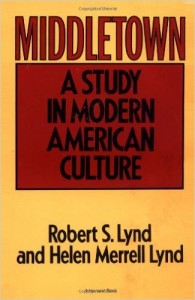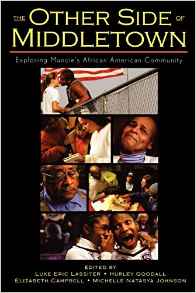Gary Younge’s month-long Guardian newspaper reportage, taking the temperature of the US Presidential election from Muncie, Indiana, is an inspired project, with great resonance. It is one that draws upon a rich, but flawed tradition of sociological studies of the town that made it one of the most studied communities in the US.
 Muncie was given the pseudonym ‘Middletown’ when it was first studied in the 1920s by Robert and Helen Lynd and has been the subject of a number of follow up studies over the ensuing decades. The initial study was commissioned by John D. Rockefeller an oil magnate who also financed the establishment of the Institute of Social and Religious Research which ‘sought religious solutions to the social problems of industrial America’ (Connolly 2005: 213). Rockefeller was increasingly concerned about the escalation in labour conflict in the US and wanted to find ways in which the hostile relations between business owners and workers could be attenuated (Caccamo 2001). To this end, he commissioned a small city study focused on examining the impact of industrialization upon the values and habits of the residents.
Muncie was given the pseudonym ‘Middletown’ when it was first studied in the 1920s by Robert and Helen Lynd and has been the subject of a number of follow up studies over the ensuing decades. The initial study was commissioned by John D. Rockefeller an oil magnate who also financed the establishment of the Institute of Social and Religious Research which ‘sought religious solutions to the social problems of industrial America’ (Connolly 2005: 213). Rockefeller was increasingly concerned about the escalation in labour conflict in the US and wanted to find ways in which the hostile relations between business owners and workers could be attenuated (Caccamo 2001). To this end, he commissioned a small city study focused on examining the impact of industrialization upon the values and habits of the residents.
This study was undertaken by the Lynds and published as Middletown: A Study in Contemporary American Culture. It was very quickly taken up by academics, journalists and other commentators who saw it as representing the typicality of American society. Indeed, many people suggested that with Middletown / Muncie, the Lynds ‘had discovered a community that could stand in for the whole United States [defining its content and boundaries]’ (Igo 2005: 247).
The study projected a particular image of the town that came to be seen as quintessentially American. And its quintessence rested in the fact that it was portrayed by the Lynds as consisting of ‘a homogenous native born population, [and] a small foreign-born and Negro population that could basically be ignored’ (Hurley Goodall cited in Lassiter 2004: 1). The exclusive focus on the white population of Muncie, coupled with the disregard for its other communities, was not seen to be at all problematic in achieving the stated aim of examining the impact of industrialization upon the values and habits of the residents. Indeed, the depiction by the Lynds of this as ‘typical’ of US society was taken as credible by academics and commentators.
This was despite the fact that the African American population in Middletown / Muncie in the 1920s stood at 6% and ‘was larger as a proportion of overall population than black communities in such major northern cities as Cleveland, Detroit, Chicago and New York’ (Blocker 1996: 298, 304). In erasing the existence of African Americans from their studies, the Lynds’ analysis homogenized the city, ‘essentially creating in their text an imaginary all-white community (Bahr et al 2007: 96). As their study set the baseline for comparison for all subsequent studies, these also perpetuated the myth that Middletown / Muncie was a homogenous white community. Among the vast corpus of literature on Middletown, very few scholars turn their attention to what Eric Lassiter (2004) has termed ‘the other side of Middletown’. This erasure, and its consequences, I suggest, require continued address.
 The most successful attempt at recovering the place of African Americans in Muncie can be seen to be Eric Lassiter’s collaborative project between university faculty and students and local residents which was published in 2004 as The Other Side of Middletown. In this project, Lassiter joined forces with local resident and activist, Hurley Goodall, who had a long-standing interest in recovering the history of African Americans in Muncie. Indeed, he had published a short book in 1976 with Paul Mitchell called A History of Negroes in Muncie which emerged directly out of his concern regarding the absence of this history in the Middletown study or any of its follow up studies.
The most successful attempt at recovering the place of African Americans in Muncie can be seen to be Eric Lassiter’s collaborative project between university faculty and students and local residents which was published in 2004 as The Other Side of Middletown. In this project, Lassiter joined forces with local resident and activist, Hurley Goodall, who had a long-standing interest in recovering the history of African Americans in Muncie. Indeed, he had published a short book in 1976 with Paul Mitchell called A History of Negroes in Muncie which emerged directly out of his concern regarding the absence of this history in the Middletown study or any of its follow up studies.
While the initial neglect of other communities is beginning to be addressed, what I would like to take up and expand upon here is a little different. I am interested in how the presentation of Middletown within standard sociological texts, while empirically inadequate, did nonetheless reflect dominant conceptions of the US at the time (and perhaps continues to do so). That is, it reinforced the conception of the US as a homogenous white society where other (and specifically African American) populations were seen to be marginal and unnecessary to understanding US society itself. It is the normalization of these exclusions, both at the time and in their portrayal retrospectively, and how these come to shape what is considered to be sociologically significant and in need of explanation, that is of greatest concern to me.
The stated aim of the Lynds’ initial project was to address the issue of increasing class conflict within US society. By not seriously addressing the demographic constitution of Muncie, and indeed, deliberately simplifying the racial diversity of the city, they missed some key aspects of its social dynamics which, I argue, bring into question the sociological claims they otherwise make. One of the key issues that the Lynds discussed in Middletown, in relation to addressing the relationship between business owners and workers, was the relative lack of unionization in Muncie. While lamenting ‘a lack of working class consciousness’ as the most significant factor in this, as Connolly suggests, the Lynds most likely missed ‘a key reason for its absence by constructing an artificial racial homogeneity in Middletown’ (2005: 223). Their explanations covered a number of other issues but did not address perhaps the most relevant: that ‘the presence of a growing number of black workers may well have hindered unionization in Muncie’ (Connolly 2005: 221; see also Blocker 1996).
It has to be recalled that US society at this point was deeply divided along racial lines and while formal segregation did not exist to the same extent in Muncie as in many southern states of the US, it still demonstrated pervasive forms of discrimination across social, political and economic spheres (Blocker 1996: 314). To the extent that unions did exist, for example, African American workers were routinely barred from union membership and many jobs were only available to those who held union membership. In this way, social and political segregation translated into economic segregation and created African Americans as a potential threat in that through their enforced position as casual labourers they could potentially be brought in to undercut and displace a truculent unionized white workforce. By failing to consider such issues, the Lynds’ sociological analysis of the lack of unionization can be seen to be deficient.
With both ‘Brexit’ and Trump’s ‘nativist’ presidential campaign, there have been those who have suggested that both campaigns draw upon the pain of those ‘left behind’ by globalization. What the history of Muncie / Middletown demonstrates is that there is also a story of those ‘left out’ of previous economic prosperity and its decline, people who never benefited from the periods of prosperity and are experiencing similarly precarious lives in the present. Muncie’s intertwined history of class and race speaks directly to the present and the divisions that undermine political community both in the USA and the UK.
References:
Bahr, Howard M., Mindy Judd Pearson, Leif G. Elder, Louis Hicks 2007. ‘Erasure, Convergence, and The Great Divide: Trends in Racial Disparity in Middletown,’ City & Community 6 (2): 95-117.
Blocker Jr., Jack S. 1996. ‘Black Migration to Muncie, 1860–1930,’ Indiana Magazine of History 92 (4): 297-320
Caccamo, Rita 2000. Back to Middletown: Three Generations of Sociological Reflections. Stanford: Stanford University Press.
Connolly, James J. 2005. ‘The Legacies of Middletown: Introduction,’ Indiana Magazine of History, 101 (3): 211-225
Igo, Sarah E. 2005. ‘From Main Street to Mainstream Middletown, Muncie, and “Typical America”,’ Indiana Magazine of History, 101 (Sept): 239-266
Lassiter, Luke Eric, Hurley Goodall, Elizabeth Campbell and Michelle Natasya Johnson 2004. The Other Side of Middletown: Exploring Muncie’s African American Community. Walnut Creek, CA: AltaMira Press.
Just came across this. Good stuff. Younge got his arms around a lot more than the usual journalistic one-off here. You should come visit us in Middletown some time.
Thanks! Would love to – very much appreciated your work on this.